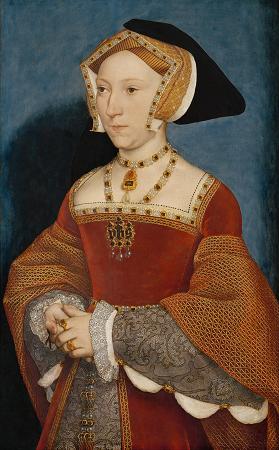Jane Seymour (1536). Jane Seymour was Queen of England from 1536 to 1537 as the third wife of King Henry VIII. She succeeded Anne Boleyn as queen consort following the latter's execution in May 1536. She died of postnatal complications less than two weeks after the birth of her only child, a son who became King Edward VI. She was the only one of Henry's wives to receive a queen's funeral, and his only consort to be buried beside him in St George's Chapel, Windsor Castle. Jane, the daughter of Sir John Seymour and Margery Wentworth was most likely born at Wulfhall, Wiltshire, although West Bower Manor in Somerset has also been suggested, Her birth date is not recorded; various accounts use anywhere from 1504 to 1509, but it is generally estimated as occurring in or around 1508. Through her maternal grandfather, she was a descendant of King Edward III's son Lionel of Antwerp, 1st Duke of Clarence. Because of this, she and King Henry VIII were fifth cousins. She shared a great-grandmother, Elizabeth Cheney, with his second and fifth wives, Anne Boleyn and Catherine Howard. Jane was not as highly educated as Henry's first and second wives, Catherine of Aragon and Anne Boleyn. She could read and write a little, but was much better at needlework and household management, which were considered much more necessary for women. Her needlework was reported to be beautiful and elaborate; some of her work survived as late as 1652, when it is recorded to have been given to the Seymour family. After her death, it was noted that Henry was an enthusiastic embroiderer. Jane became a maid-of-honour in 1532 to Queen Catherine, but may have served her as early as 1527, and went on to serve Queen Anne. The first report of Henry VIII's interest in Jane was in February 1536, about three months before Anne's execution. Jane was highly praised for her gentle, peaceful nature, being referred to as gentle a lady as ever I knew by John Russell and being named as the Pacific by the Imperial Ambassador Eustace Chapuys for her peacemaking efforts at court. According to Chapuys, she was of middling stature and very pale; he also commented that she was not of much beauty. However, John Russell stated that she was the fairest of all the King's wives. Polydore Vergil commented that she was a woman of the utmost charm in both character and appearance. She was regarded as a meek, gentle, simple, and chaste woman, whose large family made her a suitable candidate to give birth to many children. The Six Wives of Henry VIII Catherine of Aragon. Anne Boleyn. Jane Seymour. Anne of Cleves. Catherine Howard. Catherine Parr. Henry VIII was betrothed to Jane on 20 May 1536, just one day after Anne Boleyn's execution. They were married at the Palace of Whitehall, Whitehall, London, in the Queen's closet by Bishop Gardiner on 30 May 1536. As a wedding gift he made her a grant of 104 manors in four counties as well as a number of forests and hunting chases for her jointure, the income to support her during their marriage. She was publicly proclaimed queen on 4 June 1536. Her well-publicised sympathy for the late Queen Catherine and her daughter Mary showed her to be compassionate and made her a popular figure with the common people and most of the courtiers. She was never crowned because of plague in London, where the coronation was to take place. Henry may have been reluctant to have her crowned before she had fulfilled her duty as a queen consort by bearing him a son and a male heir. As queen, Jane was said to be strict and formal. The lavish entertainments, gaiety, and extravagance of the queen's household, which had reached its peak during the time of Anne Boleyn, was replaced by a strict enforcement of decorum. For example, she banned the French fashions that Anne had introduced. Politically, Jane appears to have been conservative. Her only reported involvement in national affairs, in 1536, was when she asked for pardons for participants in the Pilgrimage of Grace. Henry is said to have rejected this, reminding her of the fate her predecessor met with when she meddled in his affairs. Her motto as a queen was Bound to obey and serve. Jane formed a close relationship with her stepdaughter Mary. Jane put forth much effort to restore Mary to court and to the royal succession, behind any children that she might have with Henry. She brought up the issue of Mary's restoration both before and after she became queen. While she was unable to restore Mary to the line of succession, she was able to reconcile her with Henry. Eustace Chapuys wrote to Emperor Charles V of her compassion and efforts on behalf of Mary's return to favour. A letter from Mary to her shows that Mary was grateful to her.
more...






